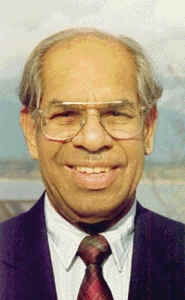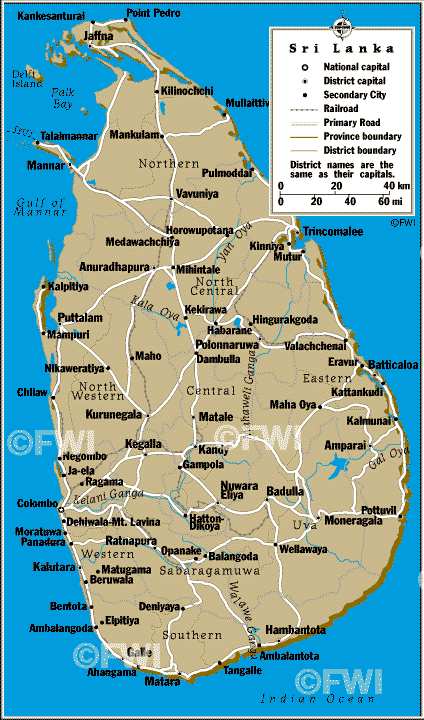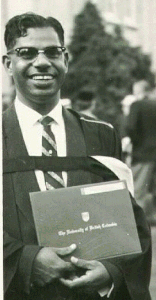Pullikattil Simon
Research Microbiologist
Country Of Origin: India/Sri Lanka
Home Town: Vancouver
Home Province: British Columbia
sangam.org/articles/view2/656.html

Pullikattil Simon
In 1956 when the race riots took place in Sri Lanka, I was right in the middle of it and escaped death many times. What caused the race riots? Several factors.
First, the government of Sri Lanka introduced Singhalese as the official language of the country. Second, land in a Tamil area was distributed to Singhalese people. Hon. D.S. Senanayake, the Prime Minister of Ceylon, constructed a dam across the Gal Oya River, which runs through the Tamil-dominated Eastern Province, and created a reservoir to irrigate about 150,000 acres to grow paddy. He distributed the irrigable land to Singhalese peasants, 5 acres of dry land and 2 acres of wet land, along with a house, a pair of draught bulls, a milk cow, and poultry for egg production.
 In a few years, the Singhalese colonists became rich farmers while the Tamils remained landless poor. The Tamils felt that their land was being given away to the Singhalese by a Singhalese government controlled by a Singhalese Prime Minister. This created ill feeling between the Singhalese and the Tamils. Because of their majority and the official Singhalese language, the Singhalese felt like rulers of the land and treated the Tamils poorly. The situation flared up into race riots in 1956.
In a few years, the Singhalese colonists became rich farmers while the Tamils remained landless poor. The Tamils felt that their land was being given away to the Singhalese by a Singhalese government controlled by a Singhalese Prime Minister. This created ill feeling between the Singhalese and the Tamils. Because of their majority and the official Singhalese language, the Singhalese felt like rulers of the land and treated the Tamils poorly. The situation flared up into race riots in 1956.
As veterinarian in charge of livestock improvement for the colonists, I was located in the centre of the agricultural section. When the riot broke out, I was in an isolated area. Though my mother-tongue was Malayalam (neither Tamil nor Singhalese), my Singhalese friends suggested that I would be safer if I moved in with them at Uhana. Therefore, I and my family moved in with them. From the house, I could observe people in the marketplace about 200 yards below on the flat land. I could see that whenever the Singhalese had an excuse to beat up a lone Tamil labourer, they did so to keep the Tamils under control.
Three days after I moved into the house of my friend Thomas at Uhana, the Singhalese rioters gathered together and went in search of Tamils living with Singhalese friends. News reached us that the rioters were coming to our bungalow to see if we were Tamils. Thomas advised me to hide in the forest if they came. He said that my wife and children would be safe because the mob was attacking only men.
At nightfall, when we saw a crowd of about 500 coming towards our bungalow, I left by the back door and ran into the forest adjoining the courtyard. In the dark, I fell into a gully and was not able to get up. When the leader of the mob saw my wife, he recognized her and told the mob that she was the wife of Dr. Simon who had saved his son from drowning two months previously. His presence saved us and he was very apologetic. After the mob left, Thomas came in search of me and helped me to go back into the house.
We realized that it was not safe to stay there – the next time there would probably not be a man among the rioters who knew us. So, we decided to get away to Batticaloa, a Tamil town about 40 miles away. This was a dangerous move because the mob was everywhere searching for Tamils escaping to Tamil areas. A mob could stop my rover at any time and kill us. The next day, I drove through the crowd slowly, determined not to stop even if I had to run someone over. The crowd gave room and we went to Samanthurai, a Muslim village. There were three Singhalese men in that village afraid for their lives. They begged me to take them to Uhana. I knew the danger if I went back. But I had to save these people. So I drove them to within a mile of Uhana.
On my way back to Samanthurai, I saw dust rising from the road and realized that a vehicle was coming. I stopped my rover at a wide point so that I would be able to escape if the oncoming vehicle tried to block me. The lorry driver saw the dust my vehicle created and stopped in a narrow area to block me. We both waited. The lorry driver finally started his vehicle and came forward to investigate. When it neared, I, with an authoritative motion of my hand, ordered the driver to come forward and move to make room for me to go. He obeyed and I drove off. It was a lorry with about 30 people with guns and clubs searching for Tamils escaping from Gal Oya. The folks in the lorry could not get a good look at me to determine whether I was Singhalese or Tamil and so they turned around and tried to follow me. My rover was more powerful and I escaped a second dangerous encounter.
We stayed in Batticaloa for about a month until the situation settled down in Gal Oya valley. But these events prompted me to leave Sri Lanka and I saw an advertisement about Canada looking for immigrants. The scenery, wild life and beauty of Canada was indescribable and I fell in love with the country.

Pullikattil Simon
I decided to apply for postgraduate studies at UBC. Dr. Evans Hardy of Saskatoon, was the United Nation’s Agricultural Advisor to the Government of Ceylon (Sri Lanka ) at that time. We both were working to help the colonists and became friends. He gave a letter of introduction to Dr. Stanley Wood, a professor at UBC. The letter shocked me out of my wits for he had concluded his letter with the remark, “Simon will be an asset to Canada.”
I forwarded a copy of his letter to Dr. K.F. Wells, Director General of Agriculture and Veterinary Science in Canada. I did not know at the time that Dr. Evans and Dr. Wells were friends. Luckily, the department was in need of veterinarians for meat inspection, and Wells asked me to send an application to the Civil Service Commission for selection. I was selected. Wells asked me to join the department immediately.
I came and joined the department in Vancouver and was quite happy. I forgot that I had come to study at UBC. On the first day of classes in 1956, I remembered that I had to register. I met Dr. C.E. Dolman, head of the department of Bacteriology, and started at UBC.
Now I was a full-time employee at the Department of Agriculture and a full-time student at UBC. My fellow workers at the plant were very helpful to me by exchanging hours of work to help me schedule classes. When I started my research on Sphaerophorus necrophorus, I requested a transfer from meat inspection to the pathology lab at the UBC campus and I was granted permission. This helped a great deal.
Sometimes I had six cultures to examine and measure their growth. I would go home for a few hours to sleep between 1 am and 6 am. Sometimes the night watchman would come to the lab for midnight rounds and would see all the lights burning; thinking that someone had forgotten to switch them off, he would switch them off and then I would shout from the other end of the lab to switch them back on. Sometimes when he came back the next morning at the end of his shift, I would be there. He thought I was there all night.
Thus, by hard work, in two years I completed my course which Dr. Dolman thought would take me four years. I worked day and night enthusiastically and with determination. I had to catch up in microbiology what I had lost between 1936 and 1957. Microbiology had changed a lot during that period in the names of organisms, methods of isolation and identification. In addition to microbiology, I took many extracurricular courses, including organic chemistry, gas chromatography, histology, light microscopy and electron microscopy, as well as financial management, plumbing, carpentry, and TV repair. I also obtained a private pilot’s licence and enjoyed flying my Cessna 150.